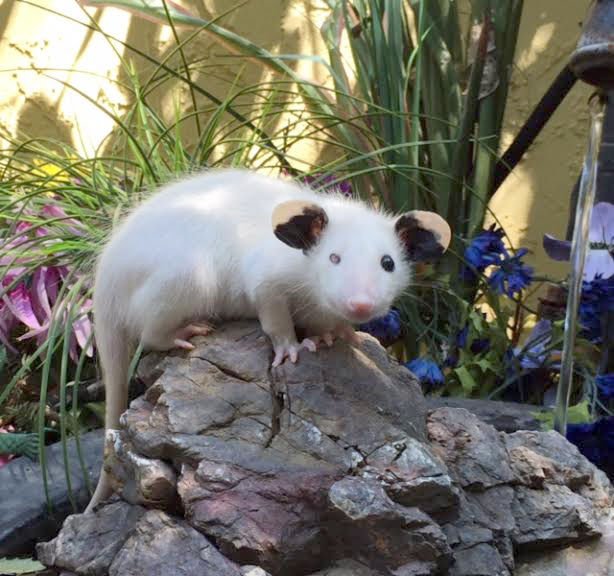
Welcome Uno, the Wildlife Education and Rehabilitation Center’s new educational opossum. He originally arrived at the Wildlife Center of Silicon Valley on the Fourth of July, a tiny pink baby weighing only 30 grams (the weight of four grapes.)
Uno was a healthy critter, but because he is leucistic (a lack of pigmentation resulting in white hair, feathers or scales) and missing his right eye—hence, his name—it was determined that he would only have a slight chance of surviving in the wild and was not releasable. His coloration would make him stand out to predators and his diminished vision would reduce his ability to avoid those predators. That’s two strikes against him.
Fortunately, he was deemed suitable for placement. On July 31, Uno was transferred to WERC for evaluation where he has proved to be sweet-tempered and curious and have a healthy appetite. With the approval of the California Department of Fish and Wildlife, he has now joined WERC’s team of animal ambassadors.
Virginia opossums are North America’s only marsupial—animals whose females have pouches to carry their babies. They are solitary, very rarely aggressive and will not attack your pets if left alone. If hissing and baring their teeth, of which they have 50—the most of any mammal—doesn’t scare away predators like dogs, coyotes, foxes, raccoons, bobcats, eagles, hawks, owls and humans, they will “play sick” by drooling and defecating. If that doesn’t work, they will “play dead.”
Uno thrives on a diet of mice, quail, fresh fruit and other natural foods. Wild opossums survive on a similar omnivorous diet of slugs, insects such as roaches and beetles, frogs, snakes (they are resistant to venom,) small rodents, fruits and berries, and carrion—aka road kill. You could call them evening sanitation engineers. In other words, they are a real benefit to us—environmental clean-up at no cost to the taxpayers.
Uno will delight schoolchildren when he visits their classrooms during WERC’s “Feather, Fur and Scales” programs. WERC’s team of non-releasable, educational animals includes Horus (peregrine falcon), Owlivia (western screech owl), Wapeka (red-tailed hawk), Luna (great horned owl), Clarabelle (acorn woodpecker), Ariel (merlin falcon), Barnadette (barn owl), Zorro (turkey vulture), Wally (pygmy owl), Lazarus (gopher snake) and, of course, Uno.
WERC’s unique educational outreach programs inspire and educate children (and adults) about nature, wildlife and the environment and provide an up close look at some of our local native animals. These programs meet many if not all of California’s Life Science Standards for grades K-6. For more information on WERC’s classroom programs, go to werc-ca.org.
The Wildlife Education and Rehabilitation Center rehabilitates native wildlife. It is supported solely by donations from businesses and the public. To contact WERC, call
(408) 779-9372 or visit werc-ca.org.














